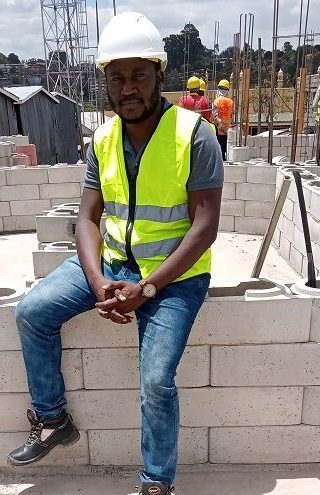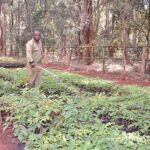
inspects an ongoing construction at Kibera Slum, Nairobi.
By Tebby Otieno|tebbyotieno62@gmail.com
Victor Ochieng lives in a single-room block house in Kibera’s Mashimoni estate with his family. He was once homeless so he’s happy to have a roof over his head.
“Life is still difficult, but once I’m in this house, I feel happy and sleep well,” says Ochieng.
Before this house was built, the 32-year-old lived in a tin-walled shack, which he once lost to a fire. Fires are common in Kibera.
“None of us saved any of our belongings. All of them burnt to ashes. The fire started in one house and spread to nearly 100 other houses, leaving us at the mercy of well-wishers,” he recalls.
Ochieng, who has lived in this informal settlement for nearly two decades, says he now feels more secure and comfortable. His house and the 13 others in this apartment block are weatherproof and fireproof, thanks to twist block building technology.
Twist block building technology is a pilot programme in informal settlements where fire problems have been the most difficult to overcome. Given that a majority of the houses in these areas are constructed of sheet metal, the technology hopes to address all these gaps and make life more comfortable for the average citizen.
“On June 5 last year, we had a fire that destroyed all 34 of our houses. So when we heard about this building technology that would save us and our tenants from future losses, we agreed to give it a try,” says Nation Mutua, a house agent.
He says they changed a lot of things with the technique to make their tenants more comfortable. The previous house tenants, for example, paid Ksh2,500 a month for rent and a separate electricity bill. The houses also lacked toilets, so tenants had to rely on public ones, which they had to pay for each time they used them. The new units have addressed some of these challenges.
“These houses may appear small, but they are larger than the ones we had previously. Our tenants now pay Ksh5,000 monthly for rent and their houses are legally wired for electricity. They also have their toilets and bathrooms,” Mutua.
“The doors have locks, as opposed to the earlier houses where tenants used padlocks that could easily be broken.”
Besides the 14 houses in Kibera, the technological project is in Kawangware, another Nairobi slum, where the engineers are building 18 classrooms, an office, and a kitchen. The classrooms have a capacity of 20-30 students each.
“This was a community school, and it was in such disrepair. So, after purchasing this land, we decided to build the school to make our students feel better. Before these, our classrooms were of iron sheets that were in poor condition,” says Walter Olando, Principal of Bethany Joy School.
Twist block is a German technology that is slowly being adopted in Kenya.
Milka Achieng, born and raised in Kibera, is the workshop manager. The 30-year-old has learned the technique and trains other youth here how to make twist blocks.
“We first heat river sand and fine aggregate and do a simple calculation to determine the percentage of water. Then we thoroughly mix it for about three-five minutes. We then put it on a vibrator for three minutes. We the leave the mixture in the workshop store for 18 hours. The next day, we mould and do curing for 28 days before the blocks are ready to use,” explains Achieng.
Concrete twist block is a construction technique that would prevent fires in densely populated informal settlements from spreading to neighbouring houses. If a fire breaks out in one room, the construction materials prevent it from spreading to the next.
The project of Start Somewhere Kenya Limited was established to ensure needy families have fordable housing that is also sustainable.
“We are proud to say that we are around 40 per cent cheaper than the normal machine-cut blocks or any other blocks in the market,” says Lazarus Asewe, project manager at Start Somewhere.
One twist block costs Ksh125.
“There are significant gaps in quality building materials and labour costs. These are the issues that this twist block technology is attempting to solve. Our columns fit in between the blocks for those buildings with formwork. As a result, you save money and time on the formwork, says Asewe.
“You can begin construction and move into your new home within three weeks. So we are working on a game-changing technology.”
He says twist blocks have no mortar between them. That means a landlord or an individual homeowner can demount them without causing damage if they want to redesign or demolish their structure. He says after demolition, the blocks will still be in good condition and can be used elsewhere.
With discussions about climate change continuing ahead of the COP-27 in Egypt, the engineers here say they are doing everything they can to reduce their carbon footprint. This is demonstrated by the solar panels installed, which they use to produce the twist blocks.
“Now we only use small amounts of cement, but we’re working on other technologies with other partners around the world to ensure zero cement and zero carbon on the production by using locally available materials like sand to cut carbon use by 100 per cent,” says Asewe.
According to studies, cement production is damaging attempts to protect biodiversity. Environmental scholars say the damage occurs during ground excavation and in the process of refining the cement, as a lot of energy primarily derived from carbon-based fuel is used.
“We need to move away from the use of fossil fuels in our manufacturing processes,” says Amos Wemanya, Senior Adviser, Renewable Energy and Just Transitions at Power Shift Africa.
Wemanya says cement manufacturing has both health and social consequences on people’s lives. In this regard, he urges stakeholders to support and embrace technologies centred on using renewable energy in construction.
“I believe that would aid in decarbonising the cement industry by shifting cement production away from coal and toward solar and wind energy, which can be stored in more stable hydrogen. As a result, we must abandon coal in favour of renewable energy technology,” he says.
Kenya was the first country to implement the twist block technique and fully commercialised it three years ago.
The programme has grown from Nairobi’s slums to Kisumu’s Ahero and other rural workshops throughout Africa, including Cape town, whose workshops are to begin operation at the end of this year. The Kenya Bureau of Standards has tested and certified it.
Start Somewhere technology was selected to join the Sheltertech Sub-Saharan Africa accelerator in August this year due to the innovation and impact of the twist blocks system for the construction of durable and adjustable homes while also creating know-how and jobs within slum areas.
“We are thrilled to partner with the next generation of housing change-makers and to assist them in further developing and growing their technologies,” said Maurice Makoloo, Habitat for Humanity’s Africa vice president.








